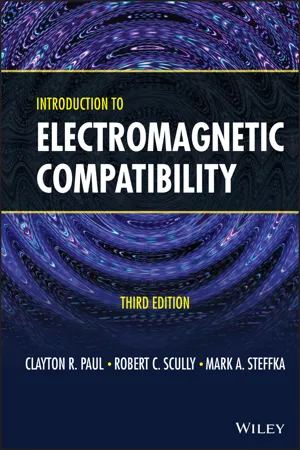
Introduction to Electromagnetic Compatibility
- English
- PDF
- Available on iOS & Android
Introduction to Electromagnetic Compatibility
About this book
INTRODUCTION TO ELECTROMAGNETIC COMPATIBILITY
The revised new edition of the classic textbook is an essential resource for anyone working with today's advancements in both digital and analog devices, communications systems, as well as power/energy generation and distribution.
Introduction to Electromagnetic Compatibility provides thorough coverage of the techniques and methodologies used to design and analyze electronic systems that function acceptably in their electromagnetic environment. Assuming no prior familiarity with electromagnetic compatibility, this user-friendly textbook first explains fundamental EMC concepts and technologies before moving on to more advanced topics in EMC system design.
This third edition reflects the results of an extensive detailed review of the entire second edition, embracing and maintaining the content that has "stood the test of time", such as from the theory of electromagnetic phenomena and associated mathematics, to the practical background information on U.S. and international regulatory requirements. In addition to converting Dr. Paul's original SPICE exercises to contemporary utilization of LTSPICE, there is new chapter material on antenna modeling and simulation. This edition will continue to provide invaluable information on computer modeling for EMC, circuit board and system-level EMC design, EMC test practices, EMC measurement procedures and equipment, and more such as:
- Features fully-worked examples, topic reviews, self-assessment questions, end-of-chapter exercises, and numerous high-quality images and illustrations
- Contains useful appendices of phasor analysis methods, electromagnetic field equations and waves.
The ideal textbook for university courses on EMC, Introduction to Electromagnetic Compatibility, Third Edition is also an invaluable reference for practicing electrical engineers dealing with interference issues or those wanting to learn more about electromagnetic compatibility to become better product designers.
Frequently asked questions
- Essential is ideal for learners and professionals who enjoy exploring a wide range of subjects. Access the Essential Library with 800,000+ trusted titles and best-sellers across business, personal growth, and the humanities. Includes unlimited reading time and Standard Read Aloud voice.
- Complete: Perfect for advanced learners and researchers needing full, unrestricted access. Unlock 1.4M+ books across hundreds of subjects, including academic and specialized titles. The Complete Plan also includes advanced features like Premium Read Aloud and Research Assistant.
Please note we cannot support devices running on iOS 13 and Android 7 or earlier. Learn more about using the app.
Information
Table of contents
- Cover
- Title Page
- Copyright
- Contents
- Preface
- Chapter 1 Introduction to Electromagnetic Compatibility (EMC)
- Chapter 2 EMC Requirements for Electronic Systems
- Chapter 3 Signal Spectra––the Relationship between the Time Domain and the Frequency Domain
- Chapter 4 Transmission Lines and Signal Integrity
- Chapter 5 Nonideal Behavior of Components
- Chapter 6 Conducted Emissions and Susceptibility
- Chapter 7 Antennas
- Chapter 8 Radiated Emissions and Susceptibility
- Chapter 9 Crosstalk
- Chapter 10 Shielding
- Chapter 11 System Design for EMC
- A The Phasor Solution Method
- B The Electromagnetic Field Equations and Waves
- C Computer Codes for Calculating the Per‐Unit‐Length (PUL) Parameters and Crosstalk of Multiconductor Transmission Lines
- D A SPICE (PSPICE, LTSPICE, etc.) Tutorial and Applications Guide
- E A Brief History of Electromagnetic Compatibility
- INDEX
- EULA